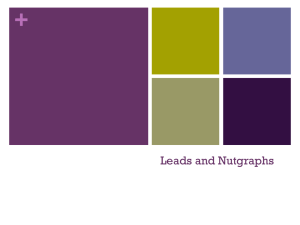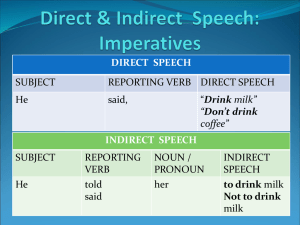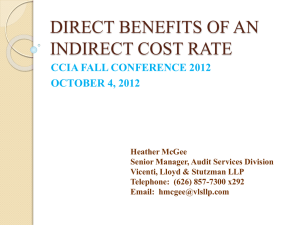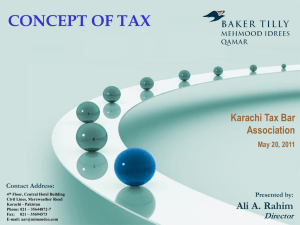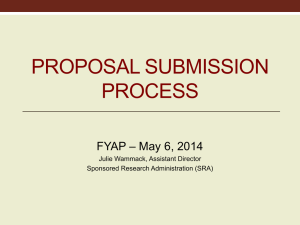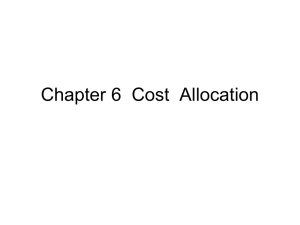Cost Allocation - Flagler College
advertisement
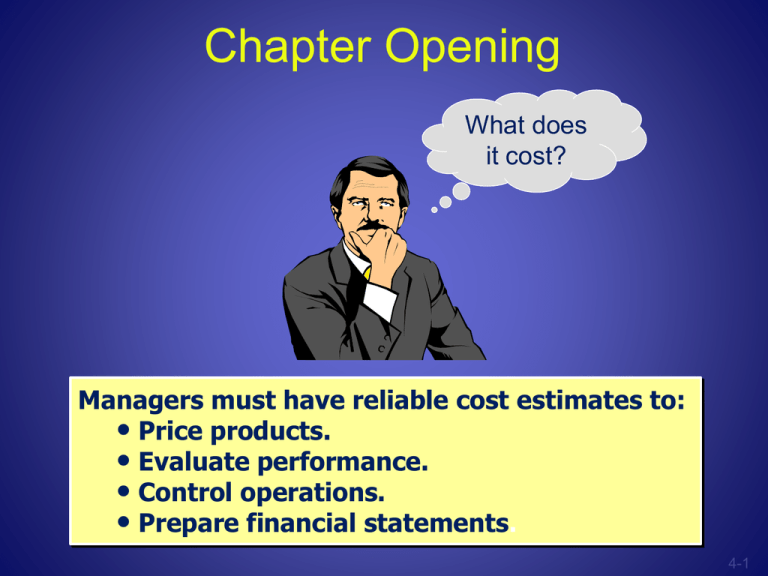
Chapter Opening What does it cost? Managers must have reliable cost estimates to: • Price products. • Evaluate performance. • Control operations. • Prepare financial statements. 4-1 Learning Objective Identify cost objects and cost drivers. LO1 4-2 Determine the Cost of Cost Objects A cost object is any activity, product, or service to which accountants wish to trace costs. Cost accumulation begins with identifying: 1. Cost objects 2. Cost drivers 4-3 Use of Cost Drivers to Accumulate Costs Units produced Machine hours A cost driver is any factor that causes or “drives” an activity’s costs Miles driven Labor hours 4-4 Use of Cost Drivers to Accumulate Costs Total Long Distance Telephone Bill Accumulated Cost Minutes X Talked = Rate per Minute Minutes talked is the cost driver. Minutes Talked 4-5 Estimated Versus Actual Cost Timely Relevant Potential Inaccuracies Estimated Costs Managers use estimated costs to make decisions about the future. 4-6 Learning Objective Distinguish direct costs from indirect costs. LO2 4-7 Identifying Direct and Indirect Costs In Style, Inc. Department Store pays a bonus to each department manager based on a percentage of departmental sales. The incentive has increased departmental sales, but departmental profits have not increased accordingly. Management has decided to base future bonuses on department profitability. Women's Sales Department Men's Children's $ 190,000 $ 110,000 $ Total 60,000 $ 360,000 4-8 Identifying Direct and Indirect Costs The first step in the development of the new bonus strategy is to determine the costs of each department. Costs that can be traced to departments in a cost-effective manner are called direct costs. Costs that cannot be traced to departments in a cost-effective manner are called indirect costs. Women's Sales Department Men's Children's $ 190,000 $ 110,000 $ Total 60,000 $ 360,000 4-9 Identifying Direct and Indirect Costs Women's Department Men's Children's Indirect Costs Direct Costs: Cost of Goods Sold $ 120,000 $ 58,000 $ 38,000 Sales Commissions 9,500 5,500 3,000 Supervisors' Salary 5,000 4,200 2,800 Depreciation 7,000 5,000 4,000 Indirect Costs: Store Manager Salary $ Store Rental 9,360 18,400 Utilities 2,300 Advertising 7,200 Supplies Totals 900 $ 141,500 $ 72,700 $ 47,800 $ 38,160 4-10 Learning Objective Allocate indirect costs to cost objects. LO3 4-11 Allocating Indirect Costs to Departments Identify the most appropriate cost Department driver for each indirect Women's Men's cost. Children's Total Direct Costs: Indirect costs should be allocated to reflect Cost ofhow Goods Sold $ 120,000 consume $ 58,000 resources. $ 38,000 $ 216,000 the departments Sales Commissions 9,500 Supervisors' Salary 5,000 Depreciation 7,000 5,500 3,000 18,000 The cost drivers of 4,200 2,800 In Style, Inc. are: 5,000 12,000 4,000 16,000 Indirect Costs Store Manager Salary Equal Portion $ 9,360 Store Rental Floor Space Occupied 18,400 Utilities Floor Space Occupied 2,300 Advertising Sales Volume 7,200 Supplies Sales Volume 900 4-12 Allocating Indirect Costs to Departments Use a two-step process to allocate indirect costs: Department Women's Allocation rate = total cost Direct Costs: Men's Children's Total ÷ cost driver activity. of Goods Sold $ 120,000 $ 58,000 $ 38,000 $ 216,000 Cost Allocated cost = allocation rate × weight of the Sales Commissions 9,500 5,500 3,000 18,000 Supervisors' Salary activity. 5,000 cost driver 4,200 2,800 12,000 Depreciation 5,000 4,000 16,000 7,000 Indirect Costs Store Manager Salary Equal Portion $ 9,360 Store Rental Floor Space Occupied 18,400 Utilities Floor Space Occupied 2,300 Advertising Sales Volume 7,200 Supplies Sales Volume 900 4-13 Allocating Indirect Costs to Departments $9,360 ÷ 3 departments = $3,120 per department $3,120 × 1 department = $3,120 Women's Indirect Costs Store Manager Salary $ 3,120 $ Store Rental Department Men's Children's 3,120 $ 3,120 $ Total 9,360 18,400 Utilities 2,300 Advertising 7,200 Supplies 900 4-14 Allocating Indirect Costs to Departments $18,400 ÷ 23,000 square feet = $0.80 per square foot $0.80 × 12,000 Women’s square feet = $9,600 $0.80 × 7,000 Men’s square feet = $5,600 $0.80 × 4,000 Children’s square feet = $3,200 Women's Indirect Costs Store Manager Salary $ 3,120 $ Store Rental 9,600 Department Men's Children's 3,120 $ 3,120 $ 5,600 3,200 Total 9,360 18,400 Utilities 2,300 Advertising 7,200 Supplies 900 4-15 Allocating Indirect Costs to Departments $2,300 ÷ 23,000 square feet = $0.10 per square foot $0.10 × 12,000 Women’s square feet = $1,200 $0.10 × 7,000 Men’s square feet = $700 $0.10 × 4,000 Children’s square feet = $400 Women's Indirect Costs Store Manager Salary $ 3,120 $ Department Men's Children's 3,120 $ 3,120 $ Total 9,360 Store Rental 9,600 5,600 3,200 18,400 Utilities 1,200 700 400 2,300 Advertising Supplies 7,200 900 4-16 Allocating Indirect Costs to Departments $7,200 ÷ $360,000 sales = $0.02 per sales dollar $0.02 × $190,000 Women’s sales = $3,800 $0.02 × $110,000 Men’s sales = $2,200 $0.02 × $60,000 Children’s sales = $1,200 Women's Indirect Costs Store Manager Salary $ 3,120 $ Department Men's Children's 3,120 $ 3,120 $ Total 9,360 Store Rental 9,600 5,600 3,200 18,400 Utilities 1,200 700 400 2,300 Advertising 3,800 2,200 1,200 7,200 Supplies 900 4-17 Allocating Indirect Costs to Departments $900 ÷ $360,000 sales = $0.0025 per sales dollar $0.0025 × $190,000 Women’s sales = $475 $0.0025 × $110,000 Men’s sales = $275 $0.0025 × $60,000 Children’s sales = $150 Women's Indirect Costs Store Manager Salary $ 3,120 $ Department Men's Children's 3,120 $ 3,120 $ Total 9,360 Store Rental 9,600 5,600 3,200 18,400 Utilities 1,200 700 400 2,300 Advertising 3,800 2,200 1,200 7,200 475 275 150 900 Supplies 4-18 Allocating Indirect Costs to Departments Department Men's Children's Women's Sales $ 190,000 $ 110,000 $ 60,000 Total $ 360,000 Direct Costs Cost of Goods Sold 120,000 58,000 38,000 216,000 Sales Com m issions 9,500 5,500 3,000 18,000 Supervisors' Salary 5,000 4,200 2,800 12,000 Depreciation 7,000 5,000 4,000 16,000 Store Manager Salary 3,120 3,120 3,120 9,360 Store Rental 9,600 5,600 3,200 18,400 Utilities 1,200 700 400 2,300 Advertising 3,800 2,200 1,200 7,200 475 275 150 900 Indirect costs Supplies Departm ental Profit $ 30,305 $ 25,405 $ 4,130 $ 59,840 4-19 Learning Objective Select appropriate cost drivers for allocating indirect costs. LO4 4-20 Using Volume Measures to Allocate Variable Overhead Costs Increases in the volume of production will cause variable overhead costs to increase. Volume measures serve as good cost drivers for the allocation of variable overhead. Units Produced Labor Hours Materials Used 4-21 Using Volume Measures to Allocate Variable Overhead Costs Chairs Product Desks Total Units of Production 4,000 1,000 5,000 Direct Labor Hours 2,500 3,500 6,000 Direct Materials Cost $ 500,000 $ 1,000,000 $ 1,500,000 Indirect Materials Cost $ 60,000 Filmier Furniture Company Production and Cost Information Use the two-step process to allocate indirect materials cost using the three volume measures as cost drivers. 4-22 Using Volume Measures to Allocate Variable Overhead Costs $60,000 ÷ 5,000 units = $12 perProduct unit Chairs Desks Total $12 per unit × 4,000 chairs = $48,000 4,000 1,000 Units of Production 5,000 Direct Hours× 1,000 desks 3,500 2,500 6,000 $12Labor per unit = $12,000 Direct Materials Cost $ 1,000,000 $ 500,000 $ 1,500,000 Indirect Materials Cost Chairs Desks $ 60,000 48,000 $ 12,000 $ 60,000 Allocation of Indirect Materials Cost Based on: Units of Production $ Direct Labor Hours Direct Materials Cost 4-23 Using Volume Measures to Allocate Variable Overhead Costs $60,000 ÷ 6,000 hours = $10 per hour Product Chairs Desks Total $10 per hour × 2,500 hours = $25,000 4,000 1,000 Units of Production 5,000 Direct Labor 3,500 = $35,000 2,500 6,000 $10 perHours hour × 3,500 hours Direct Materials Cost $ 1,000,000 $ 500,000 $ 1,500,000 Indirect Materials Cost Chairs Desks $ 60,000 48,000 $ 12,000 $ 60,000 25,000 60,000 Allocation of Indirect Materials Cost Based on: Units of Production Direct Labor Hours $ 35,000 Direct Materials Cost 4-24 Using Volume Measures to Allocate Variable Overhead Costs $60,000 ÷ $1,500,000 of direct material = $0.04 Product per dollar of direct material Chairs Desks Total Units of Production $0.04 per $ × $500,000 = 4,000 $20,000 1,000 5,000 Direct Labor Hours 6,000 3,500 2,500 $0.04 per $ × $1,000,000 = $40,000 $ 1,000,000 $ 500,000 $ 1,500,000 Direct Materials Cost Indirect Materials Cost Chairs Desks $ 60,000 48,000 $ 12,000 $ 60,000 Direct Labor Hours 25,000 35,000 60,000 Direct Materials Cost 20,000 40,000 60,000 Allocation of Indirect Materials Cost Based on: Units of Production $ 4-25 Selecting the Best Cost Driver So which volume measure should I use? 4-26 Allocating Fixed Overhead Costs Objective Distribute a fair share of the overhead cost to each product. There are no volume based cost drivers for fixed overhead. 4-27 Allocating Fixed Overhead Costs Lednicky Bottling Company Information Units Produced 2,000,000 Units Sold 1,800,000 Units in Ending Inventory Fixed Rental Cost 200,000 $ 28,000 Use the two-step process to allocate the fixed rental cost to units sold and to units in ending inventory. 4-28 Allocating Fixed Overhead Costs Units Produced 2,000,000 Units Sold 1,800,000 Units in Ending Inventory Fixed Rental Cost 200,000 $ 28,000 $28,000 ÷ 2,000,000 units = $0.014 per unit $0.014 per unit × 1,800,000 units = $25,200 $0.014 per unit × 200,000 units = $2,800 4-29 Learning Objective Allocate costs to solve timing problems. LO5 4-30 Allocating Costs to Solve Timing Problems Allocating fixed costs can be complicated when the volume of production varies from month to month. January Supervisor's Salary $ Units Produced Salary Cost per Unit Produced February 3,000 $ 800 $ 3.75 $ 3,000 1,875 1.60 If prices are based on these costs, units produced in January will be priced higher than those produced in February. Will customers think this is reasonable? 4-31 Allocating Costs to Solve Timing Problems We solve this problem by using estimated costs and estimated production for the year to obtain a predetermined overhead rate (POHR). POHR = POHR = Estimated overhead for the year Estimated allocation base for the year $36,000 18,000 units = $2.00 per unit $2.00 allocated to each unit produced for all months during the year. 4-32 Learning Objective Explain the benefits and detriments of allocating pooled costs. LO6 4-33 Aggregating and Disaggregating Individual Costs into Cost Pools Gas Water Frequently, companies accumulate many individual costs into a single cost pool. Electricity Utilities Cost Pool Pooling should be limited to costs with common cost drivers. 4-34 Learning Objective Allocate joint product costs. LO7 4-35 Allocating Joint Costs Product A Joint Costs Product B Product C Joint products – products resulting from a process with a common input. Split-off point – the stage of processing where joint products are separated. Joint costs – costs of processing joint products prior to the split-off point. 4-36 Allocating Joint Costs Joint Costs Compound AK $36,000 Joint Materials $27,000 Joint Processing $21,000 4,000 Gallons produced Split-Off Point Compound AL $12,000 Sales $50,000 COGS (36,000) GM $14,000 3,000 Gallons AK produced Additional Processing $8,000 Sales $13,000 COGS (20,000) GM ($7,000) 1,000 Gallons AL produced 4-37 Learning Objective Recognize the effects of cost allocation on employee motivation. LO8 4-38 Cost Allocation: The Human Factor Is it fair to divide the College of Business’s copy budget equally? I think we should consider the number of students. I think we should consider the number of faculty. 4-39 Cost Allocation: The Human Factor Academic Departments Management Number of Faculty 29 Number of Students 330 Actual Cost Prior Year $ 12,000 Accounting 16 360 10,000 Finance 12 290 8,000 Marketing Totals 15 72 220 1,200 6,000 36,000 Let’s see how the allocation of budgeted amounts will effect the different departments. We will begin by allocating based on the number of faculty in each department. 4-40 $36,000 ÷ 72 faculty = $500 per faculty member $500 × 29 faculty members = $14,500 Who happy? is unhappy? $500is× 16 faculty membersWho = $8,000 $500 × 12 faculty members = $6,000 $500 × 15 faculty members = $7,500 Now let’s allocate the $36,000 budget based on the number of students in each department. Academic Departments Management Accounting Finance Marketing Totals Actual Cost Prior Year $ 12,000 Allocation 14,500 Difference $ 2,500 10,000 8,000 (2,000) 8,000 6,000 (2,000) 6,000 36,000 7,500 36,000 1,500 4-41 $36,000 ÷ 1,200 students = $30 per student $30 per student × 330 students = $9,900 Who is happy? Who is unhappy? $30 per student × 360 students = $10,800 $30 per student × 290 students = $8,700 $30 per student × 220 students = $6,600 Academic Departments Management Accounting Finance Marketing Totals Actual Cost Prior Year $ 12,000 Allocation 9,900 Difference $ (2,100) 10,000 10,800 800 8,000 8,700 700 6,000 36,000 6,600 36,000 600 4-42 Learning Objective Allocate service department costs to operating departments. (Appendix) LO9 4-43 Allocating Service Center Costs – Direct Method Personnel Service Department Secretarial Service Department First-stage Allocations Civil Operating Department Criminal Operating Department Cases Cases Second-stage Allocations 4-44 Allocating Service Center Costs – Step Method Personnel Service Department Secretarial Service Department Civil Operating Department Criminal Operating Department Cases Cases First-stage Allocations Second-stage Allocations 4-45 End of Chapter 04 4-46

